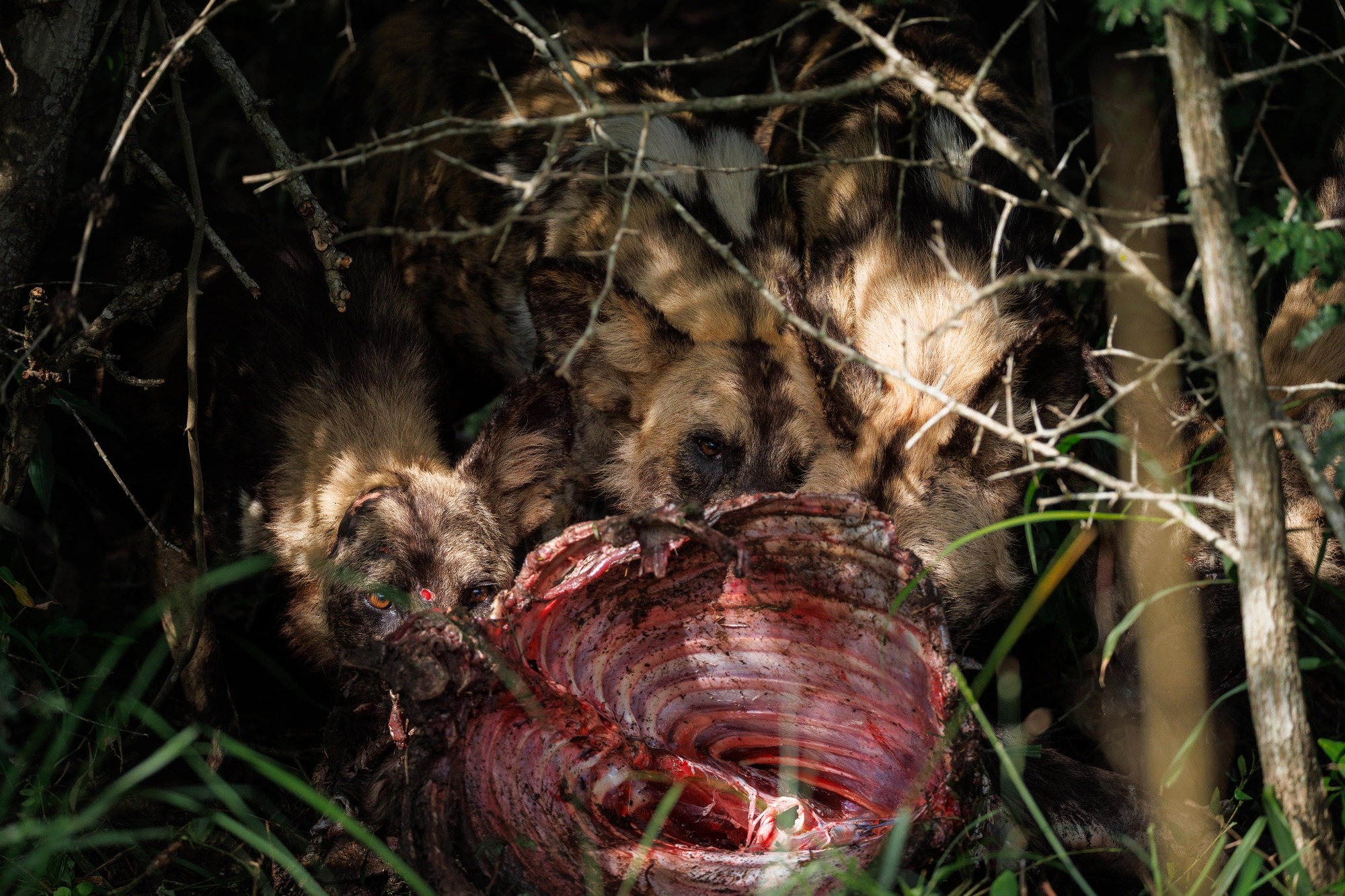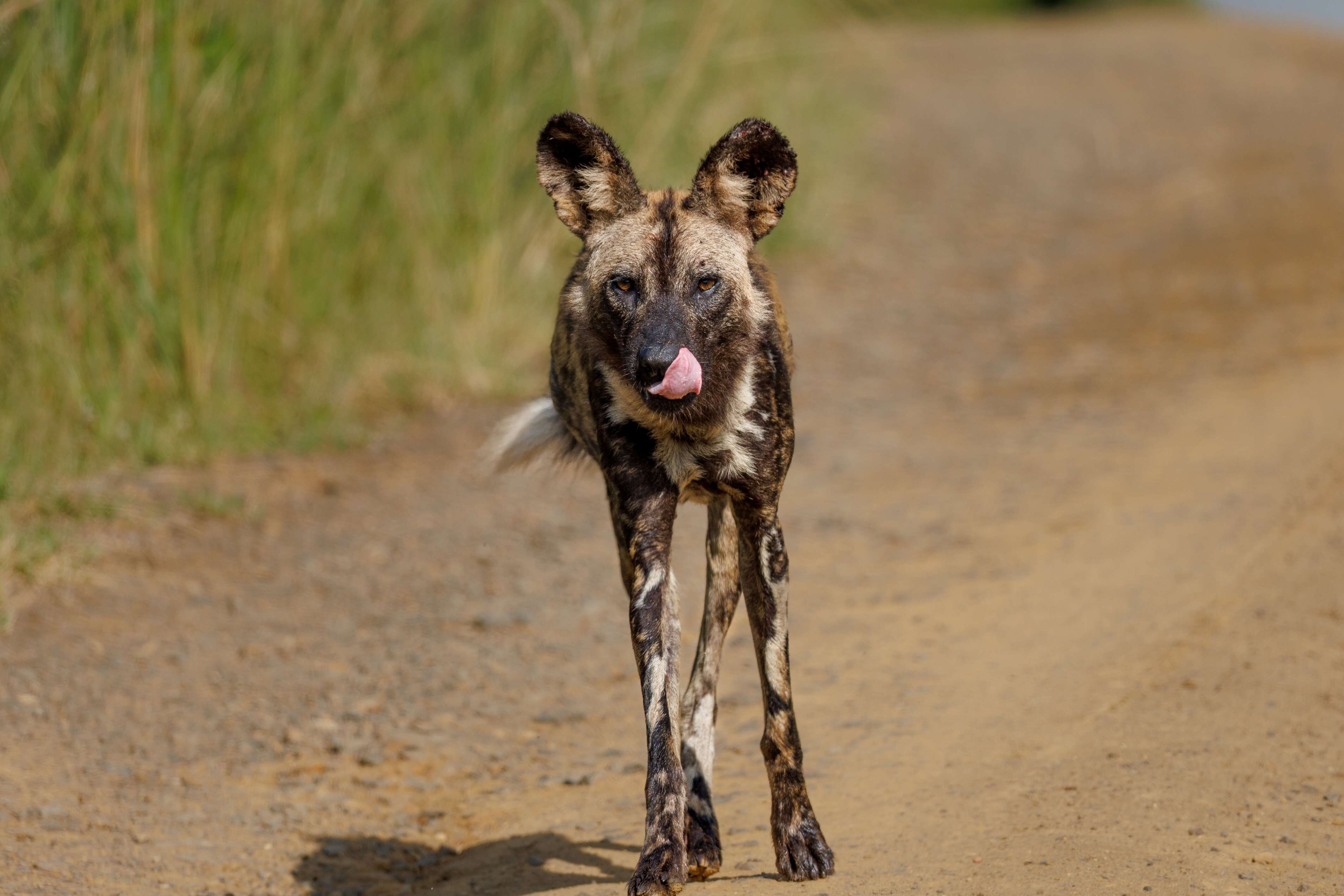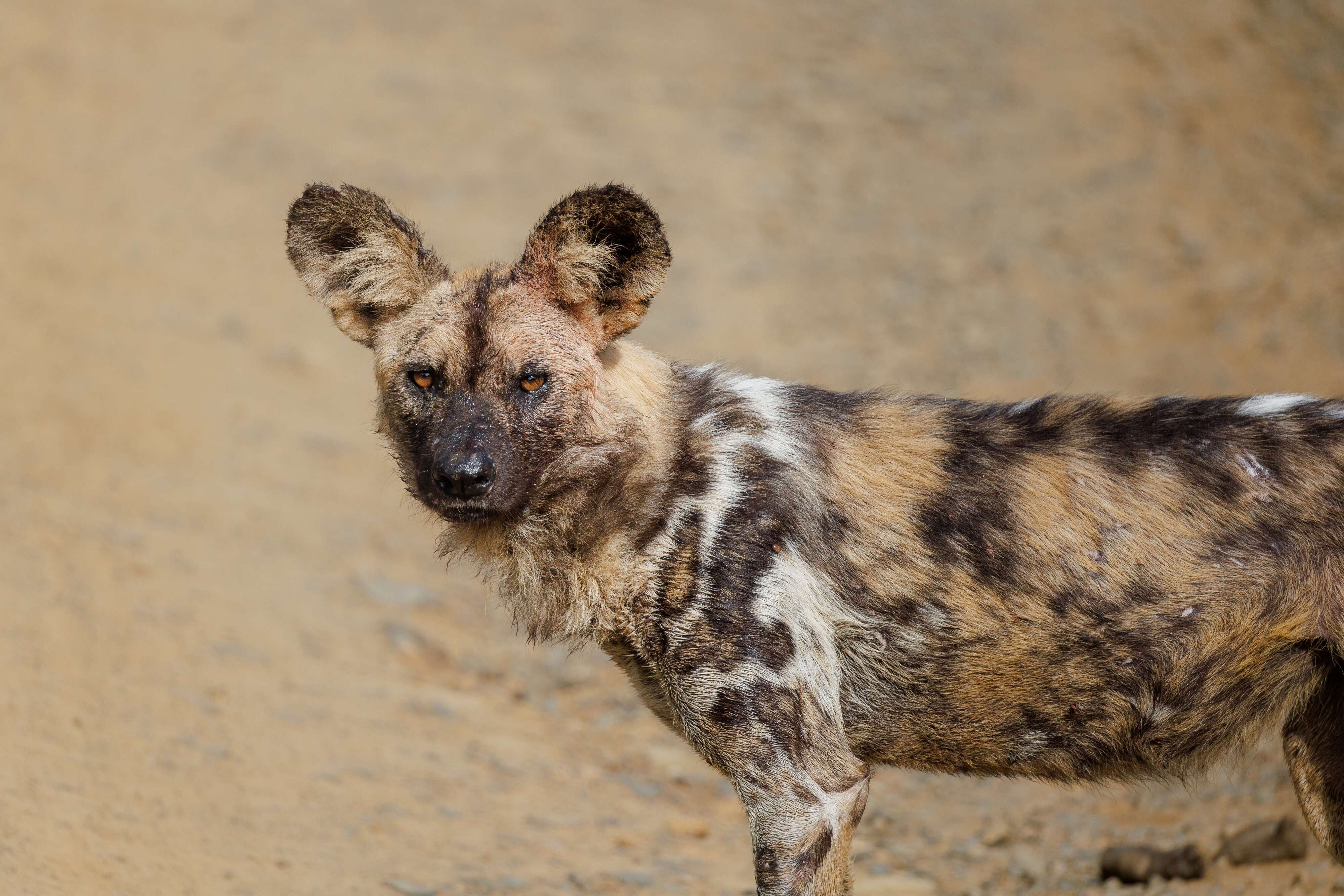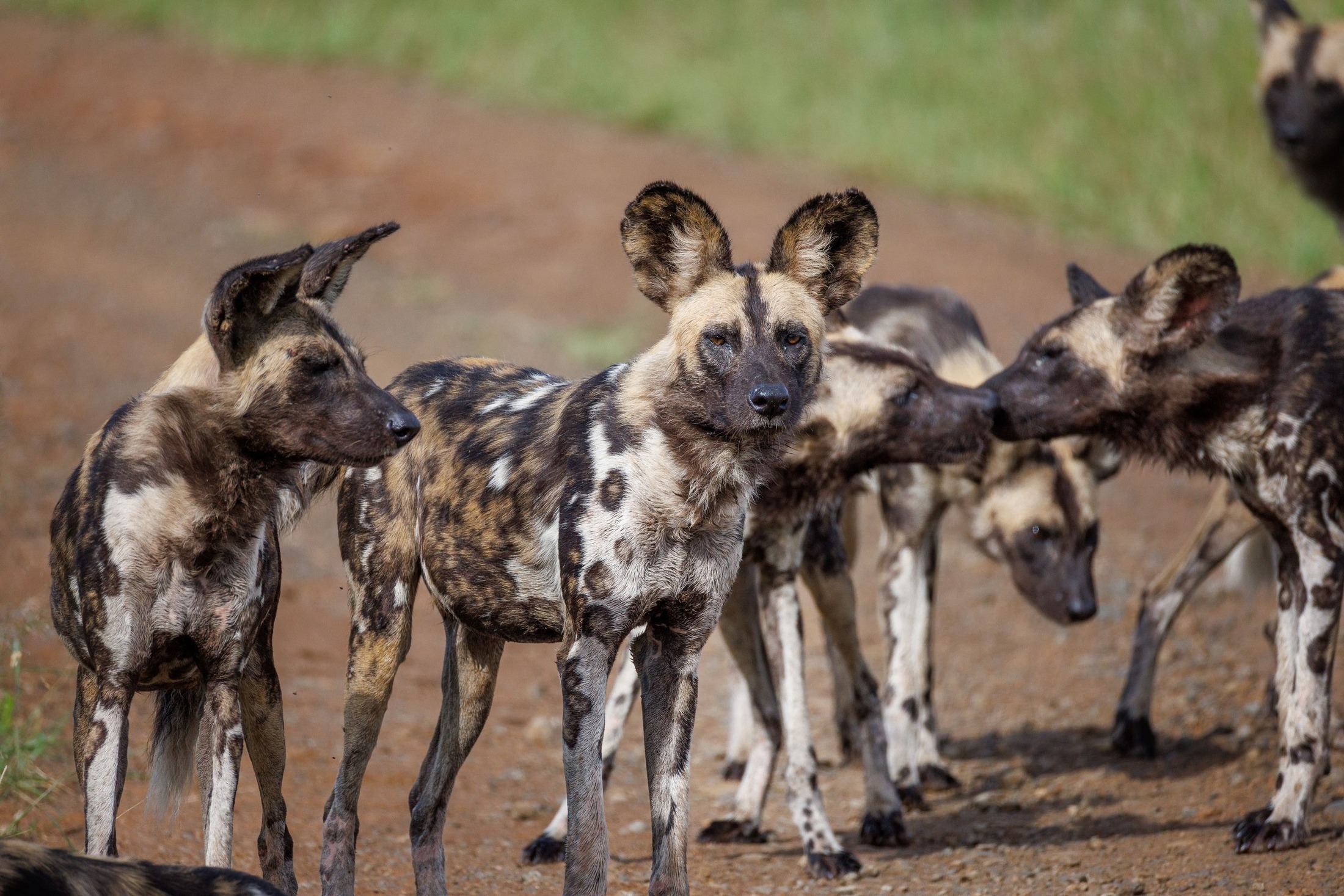Images by Wildlife ACT Volunteer, Jonathan Dutt
Understanding the African Wild Dog
The African Wild Dog (Lycaon pictus) is one of Africa’s most Critically Endangered carnivores and the only surviving member of its evolutionary genus. With a uniquely mottled coat, large, rounded ears, and a slim, athletic build, the African Wild Dog is often mistaken for a hyena or domestic dog, but it is a distinct and irreplaceable species.
Once ranging across much of sub-Saharan Africa, African Wild Dogs have lost over 90% of their historical distribution. Today, fewer than 6,600 individuals remain globally, and fewer than 1,400 mature adults contribute to breeding populations. In South Africa, where Wildlife ACT operates, African Wild Dogs are officially listed as Critically Endangered. Conservation action is urgent and essential.

Population Declines and Regional Pressures on African Wild Dogs
Data has shown that African Wild Dogs have been reduced to just a fraction of their former range, now occupying less than 10% of the area they once roamed. Across KwaZulu-Natal and other parts of South Africa, remaining populations face intense pressure from habitat fragmentation, human-wildlife conflict, and isolated population dynamics.
Wildlife ACT’s work focuses specifically on addressing these regional pressures through collaborative management, targeted translocations, advanced monitoring, and rapid response interventions. Conservation efforts today are shaped by the realities of limited space, fenced reserves, and fragmented landscapes, which makes proactive, science-based management essential to the species’ survival.
Why Are African Wild Dogs Critically Endangered?
Habitat Loss and Fragmentation
African Wild Dogs require extensive, connected landscapes to meet their ecological needs. They are highly mobile predators, often covering long distances while hunting and searching for new territories. As natural habitats are cleared for agriculture, urban development, and infrastructure, the remaining wild spaces become fragmented and isolated. This reduces access to suitable prey, confines packs to small areas, and disrupts natural movement patterns.
Fragmentation also prevents essential gene flow between populations. Without the ability to disperse safely and establish new packs, African Wild Dogs face reduced genetic diversity, which threatens the long-term resilience of the species. Wildlife ACT’s conservation work recognises that protecting and linking key habitats is critical to sustaining viable populations of African Wild Dogs in South Africa.
Human-Wildlife Conflict
African Wild Dogs are wide-ranging carnivores, and when they disperse or break through boundaries, they can occasionally prey on livestock. Such incidents pose real challenges for farmers and landowners and can lead to retaliatory action against the species.
Mitigating this conflict is a core part of African Wild Dog conservation. Wildlife ACT conducts intensive daily monitoring of collared individuals and packs, allowing early detection of dispersal or fence breaches. Rapid alerts are shared with protected area managers and neighbouring communities so that proactive steps can be taken before losses occur. This approach reduces the risk to farmers’ livelihoods while safeguarding Wild Dogs from retaliation.
By combining real-time monitoring with community engagement and practical conflict mitigation, Wildlife ACT helps build the trust and coexistence needed to secure the long-term survival of this endangered species.
Snaring and Accidental Deaths
Wire snares set for bushmeat are a widespread threat across the African Wild Dog’s range. These indiscriminate traps are often hidden and impossible for animals to detect, leading to serious injuries or fatalities when Wild Dogs pass through snare lines. The loss of a single alpha individual can have severe consequences, as African Wild Dog packs rely on their social structure for survival and reproduction.
Wildlife ACT’s monitoring and targeted collaring work are critical components of reducing accidental mortality through rapid response. By maintaining active field monitoring, conservation teams can quickly respond to snaring incidents and prevent the collapse of vulnerable packs.
Disease
African Wild Dogs live in tightly bonded social groups, which makes them particularly susceptible to disease outbreaks. Proximity to domestic dogs exposes Wild Dog populations to rabies, canine distemper, and other infectious diseases that can spread rapidly through a pack, sometimes leading to the loss of entire groups.
Low Natural Density and Dispersal Risks
African Wild Dogs naturally occur at low densities, even in the best conditions, due to their need for large territories and abundant prey. Young adults often leave their birth packs in search of new mates and territories, a process called dispersal. While this behaviour is essential for maintaining genetic diversity, it also places dispersing individuals at high risk, as they may cross into dangerous areas outside protected reserves.
Ensuring safe dispersal pathways and managing isolated populations through carefully coordinated translocations are key components of Wildlife ACT’s conservation approach. By mimicking natural dispersal movements through collaborative metapopulation management, conservationists help reduce the risks associated with isolation and small population sizes.
Conservation Actions Safeguarding the African Wild Dog
Collaborative Conservation and Metapopulation Management
Conserving the African Wild Dog requires coordinated, collaborative conservation. Wildlife ACT works with key partners, including the Wild Dog Advisory Group of South Africa (WAG-SA), the KwaZulu-Natal Wild Dog Management Group, Ezemvelo KZN Wildlife, and the Endangered Wildlife Trust, to implement a metapopulation management strategy.
Because most South African populations are restricted to small, fenced reserves, natural dispersal is impossible. Wildlife ACT helps translocate individuals between reserves to simulate dispersal, reduce inbreeding, and maintain genetic health. Thanks to this strategy, the number of packs in KwaZulu-Natal has increased significantly over the past two decades, with over one million hectares of connected wild space now available to support the species.

Advanced Monitoring and Field Response
Wildlife ACT uses GPS and VHF collars, LoRa towers, and a network of camera traps to monitor African Wild Dog movements, health, and survival. Daily monitoring enables conservation teams to detect injuries, identify snaring events, and respond rapidly to emergencies. This real-time fieldwork is crucial for maintaining pack integrity and reducing preventable deaths.
Community Engagement and Education
Long-term conservation success depends on local community support. Wildlife ACT leads education programmes that explain the ecological importance of African Wild Dogs, promote co-existence, and introduce practical conflict-reduction measures such as improved livestock protection. By working with communities, Wildlife ACT fosters coexistence and builds a foundation for sustainable conservation.
Research and Data-Driven Conservation
Wildlife ACT’s conservation decisions are guided by robust, on-the-ground data. Understanding dispersal behaviour, habitat needs, and movement patterns helps conservation teams anticipate threats and implement effective management strategies. This research also informs broader national and regional conservation planning.
Global and Regional Conservation Partnerships
The conservation of the African Wild Dog is a collaborative effort that spans regions, institutions, and sectors. No single organisation or reserve can safeguard the species in isolation. Wildlife ACT works as part of a larger network of conservation partners, including the Wild Dog Advisory Group of South Africa (WAG-SA), the KwaZulu-Natal Wild Dog Management Group, Ezemvelo KZN Wildlife, and the Endangered Wildlife Trust. Together, these organisations coordinate monitoring, translocations, emergency interventions, and education programmes to strengthen wild dog populations across South Africa.
At a regional and global level, African Wild Dog conservation is integrated into broader frameworks, such as national biodiversity action plans, regional predator conservation strategies, and international commitments under the IUCN and other global bodies. Collaborative conservation ensures that knowledge is shared, resources are pooled, and actions are aligned across boundaries — reinforcing the resilience of African Wild Dog populations and the ecosystems they help sustain.

Why Protecting the African Wild Dog Matters
The African Wild Dog plays a vital ecological role as a top predator, regulating herbivore populations and supporting ecosystem balance. Protecting this species not only prevents extinction but also helps conserve the wider landscapes and biodiversity on which many other species depend. Conservation efforts focused on African Wild Dogs contribute to the overall resilience and health of Africa’s wild spaces.
But the importance of conserving the African Wild Dog extends beyond its ecological function. As one of Africa’s most distinctive and rare carnivores, the African Wild Dog holds significant conservation value as a flagship species. Its survival draws attention to the need for protected wild spaces, integrated land-use planning, and collaborative conservation across political and community boundaries.
African Wild Dogs also generate economic and social value. Their presence in protected areas supports conservation-based tourism, which provides vital revenue and jobs for local communities. Conservation work around the species creates opportunities for environmental education, research, and skills development, strengthening local capacity for stewardship of natural resources.
Saving the African Wild Dog is not just about preventing extinction — it is about protecting the integrity of Africa’s biodiversity, supporting local livelihoods, and ensuring that future generations inherit healthy, functioning ecosystems.

The Role of Scientific Research in African Wild Dog Conservation
Effective African Wild Dog conservation relies on robust scientific research and long-term monitoring. Wildlife ACT integrates cutting-edge technology and field-based data collection to inform conservation decisions and management strategies.
Telemetry, including GPS and VHF collars, allows conservationists to track pack movements, study dispersal patterns, and understand how African Wild Dogs use their environment. This information is critical for identifying key habitat corridors, planning translocations, and mitigating human-wildlife conflict. Population viability analyses help assess the genetic health and long-term sustainability of isolated populations, ensuring that management interventions strengthen, rather than undermine, overall conservation goals.
In addition, research into disease dynamics, prey availability, and habitat change provides essential insights into the challenges facing African Wild Dogs. By grounding its work in evidence and continually adapting strategies based on scientific findings, Wildlife ACT ensures that conservation actions are both effective and sustainable over the long term.
How Volunteering Supports African Wild Dog Conservation
Volunteering with Wildlife ACT provides a direct, hands-on way to contribute to African Wild Dog conservation in Zululand. Volunteers assist with daily field monitoring, helping conservation teams track pack movements, observe behaviour, collect data, and support critical interventions such as anti-snaring patrols and collaring operations.
By increasing monitoring capacity and providing vital field support, volunteers strengthen Wildlife ACT’s ability to protect African Wild Dog populations. This work ensures that conservation efforts remain proactive, data-driven, and responsive to emerging threats.
For those ready to contribute meaningfully to the conservation of one of Africa’s most Critically Endangered predators, Wildlife ACT’s Zululand volunteer programme offers the opportunity to be part of a dedicated, on-the-ground conservation team helping secure the future of the African Wild Dog.
Protecting the Future of the African Wild Dog
The African Wild Dog is one of the continent’s most endangered carnivores and faces an uncertain future without continued conservation action. Their survival depends on large, connected landscapes, proactive monitoring, and strong coexistence with people living alongside protected areas. Through daily fieldwork, rapid response, and community partnerships, Wildlife ACT is helping to reduce threats and support the long-term recovery of this remarkable species.
Protecting African Wild Dogs is about more than saving a single species. It is about safeguarding the health of ecosystems, supporting local communities, and ensuring that future generations inherit landscapes where wildlife still thrives. By working together, we can secure a future in which the African Wild Dog remains an enduring symbol of resilience and cooperation in the wild.



.jpg)


.jpg)

